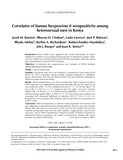| dc.contributor.author | Baeten, Jared M | |
| dc.contributor.author | Chohan, Bhavna H | |
| dc.contributor.author | Lavreys, Ludo | |
| dc.contributor.author | Rakwar, Joel P | |
| dc.contributor.author | Ashley, Rhoda | |
| dc.contributor.author | Richardson, Barbra A | |
| dc.contributor.author | Mandaliya, Kishorchandra | |
| dc.contributor.author | Bwayo, JJ | |
| dc.contributor.author | Kreiss, Joan K | |
| dc.date.accessioned | 2013-07-26T06:43:02Z | |
| dc.date.available | 2013-07-26T06:43:02Z | |
| dc.date.issued | 2002 | |
| dc.identifier.citation | AIDS: 18 October 2002 - Volume 16 - Issue 15 - pp 2073-2078 | en |
| dc.identifier.uri | http://www.ncbi.nlm.nih.gov/pubmed/12370507 | |
| dc.identifier.uri | http://erepository.uonbi.ac.ke:8080/xmlui/handle/123456789/51381 | |
| dc.description.abstract | Background: Several studies have suggested that sexual transmission of human
herpesvirus 8 (HHV-8) occurs among homosexual men in developed countries. However,
few studies have examined heterosexual HHV-8 transmission, especially among
African populations in which HHV-8 is endemic.
Objectives: To determine the seroprevalence and correlates of HHV-8 infection
among heterosexual African men.
Design: Cross-sectional study.
Methods: Participants were 1061 men enrolled in a prospective cohort study of risk
factors for HIV-1 acquisition among trucking company employees in Mombasa,
Kenya. Stored frozen sera from the study baseline visit were tested for antibodies to
HHV-8 by whole-virus lysate ELISA.
Results: HHV-8 seroprevalence was 43%. In multivariate logistic regression analysis,
HHV-8 infection was independently associated with older age [for men aged 30–39
years: odds ratio (OR), 1.5; 95% confidence interval (CI), 1.1–2.0; for men aged > 40
years: OR, 1.7; 95% CI, 1.1–2.7, compared with men aged , 30 years], Christian
religion (OR, 1.6; 95% CI, 1.2–2.1), being uncircumcised (OR, 1.5; 95% CI, 1.0–2.2),
and ever having syphilis (OR, 2.2; 95% CI, 1.4–3.5). Ever having used condoms was
associated with decreased likelihood of infection (OR, 0.7; 95% CI, 0.6–1.0).
Seropositivity was not significantly related to other sexual behaviors characterized or
to HIV-1 status.
Conclusions: HHV-8 seropositivity is common in this population and increases with
age, suggesting on-going transmission during adulthood. Infection was more common
among men who were uncircumcised or who had ever had syphilis and was less
common among those who had ever used condoms, suggesting that sexual factors
may play a role in HHV-8 transmission. Prospective studies of HHV-8 acquisition in
heterosexual African populations are needed to demonstrate whether safer sexual
practices can reduce transmission. | en |
| dc.language.iso | en | en |
| dc.subject | HHV-8 | en |
| dc.subject | Circumcision | en |
| dc.subject | Sexually transmitted diseases | en |
| dc.subject | HIV-1 | en |
| dc.subject | Heterosexual transmission | en |
| dc.title | Correlates of human herpesvirus 8 seropositivity among heterosexual men in Kenya | en |
| dc.type | Article | en |
| local.publisher | Department of Medical Microbiology, University of Nairobi, Kenya. | en |
| local.publisher | Departments of Epidemiology, Laboratory Medicine, Biostatistics, and Medicine, University of Washington, Seattle, USA, | en |
| local.publisher | Coast Provincial General Hospital, Mombasa, Kenya. | en |

